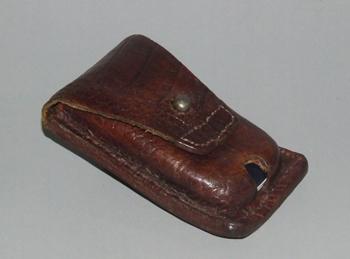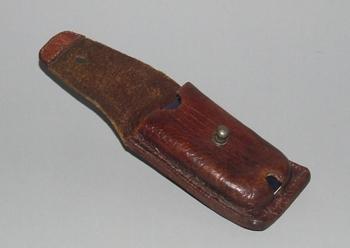-
Posts
5,928 -
Joined
Content Type
Profiles
Forums
Events
Blogs
Gallery
Everything posted by fredk
-

buckle & strap placement body or lid/flap?
fredk replied to ASAuLTCases's topic in How Do I Do That?
It depends on their use. What they are required to do. On a tool roll where you just want the whole roll not to un-roll, just about any leather will do for the strap.. Generally, on a ladies handbag, lightweight leather can be used as well, but on a dispatch rider's bag where the bag may be bulging over-filled you want a stout leather that will not stretch. an off course example; the bonnet and boot lid on my 1930 Austin 7 are held closed by leather straps. The belts need to be pulled really tight to hold the panels secure. Sometime prior to me getting the Austin someone had replaced the belts. They used too thin and too stretchy a leather, you could see the wear in each successive hole where the belts had been pulled tighter and the next hole had to be used as the leather stretched. I replaced all the belts with 3.5mm thick from a back-bone area. Very minimal stretch after 15 years of use. -
As we are sharing photos of our phone holsters, here's mine. About 18 - 20 months in daily use. The area around the hole for the stud has softened over time. It could do with improving
-

buckle & strap placement body or lid/flap?
fredk replied to ASAuLTCases's topic in How Do I Do That?
6 of one 1/2 dozen of the other. As for 'rules'; what ever suits you or the construction. On shoulder/handbags bags its better to have the buckle attached to the bottom then you're not fighting gravity to get the strap up through a buckle, but gravity helps to get the strap down thru the buckle. I always prefer the buckle strap to be short, on the 'bottom' end of anything. -
Some snaps are incredibly difficult to open. If I have any of these I run a file around the ridge above the groove which the spring grips. I take just a smidgen off it. This loosens the grip just a tad. The snap still hold tight but it just doesn't need that screwdriver to open it. Another thing I've had to do is put a piece of thin brass between two layers of leather. A hole in the brass for the snap's shaft to go thru and the brass extending to where a person grips to pull the snap open. This was on a repair - improvement where the leather had stretched and pulled out over the head of the snap
-
I find that with frequent use velcro becomes useless. tbh when I make a new phone holster I'll be doing the the strap & loop closure. The SB stud can be a nuisance
-
I use a 'Sam Brown' stud on my phone holster. Inside the holster the screw part is covered with a piece of pigs-skin lining
-
yup. 6 oz = 2.4mm, Main belt also about 2.4, = about 5mm, the minimum sort of thickness for a sword belt. Sword weighs in at 1.25 to 2 Kg. Some sword users like to wear the scabbard as well, thats another 1kg with its bits. Too thin or too light a leather and the belt just twists and collapses I only ever had to do a really thick belt, 6.5mm or so once. Most sword belts were in the region of 4 to 4.5 mm 1 oz = 0.4mm 6 oz = 2.4mm 5 mm = 12.5 oz 6.5mm = 16 oz 4 mm = 10 oz
-
I read it over there. All I can think of is its a chrome tanned split. Good for thin belts, lining thicker belts or for making handbags/shoulder bags with a 'rustic' look
-
I got my US and CS stamps from duckcreektraders, aka Bunk House Tools https://www.shop.bunkhousetools.com/Embossing-Plates_c4.htm About 1/4 way down for the CS and 2/3 down for the US Heres a better look, different sizes, closer to the top of the page https://www.shop.bunkhousetools.com/Embossing-Plates_c4.htm?sortOrder=2
-

homemade recipe for preparing liquid carnuba wax.
fredk replied to paloma's topic in How Do I Do That?
My opinion on this. Carnauba on its own might be fine for edge burnishing but not for surface polishing on flexible leather. Carnauba is a very hard wax. Its used on wood furniture because of its hardness. Its used in the French Polishing technique, as a final coating polish because of its hardness. On leather, the leather first absorbs the turps, but the leather does not absorb the wax which remains on the surface of the leather. The wax dries out and the wax continues to harden. As it hardens it will form cracks and eventually crack and break off the leather surface That is why its usually mixed with beeswax. Beeswax is actually a bee reprocessed honey. A honey bee is fed honey and it processes it in its body and extrudes platelettes of wax. For every 6 to 7 pounds of honey 1 pound of wax is made. Beeswax has a lower melting temperature and also contains more moisture which helps it to be absorbed into leather. But beeswax on its own is a poor polish so carnauba, which is from a tree, is added for hardness My qualifications on this are; Once upon a time I was a bee keeper. I used to make polishes for car-finishers, furniture polishers, leatherworkers and more. I attended certain instruction courses to learn about polishes so I could mix polishes to suit the end users. Some end users used to travel from all over this island to search me out for my polishes. I wasn't in the Turtlewax league but specialists preferred my polishes -
The only 'Gorilla' glues I can find locally are an expensive Cyanoacrylate (aka CA, or Superglue) or an expensive PVA. (about £10 for 125ml)
-
I've made light-weight 'medieval' style shoes and ankle boots. The thickest I've used for the sewn on sole is 2.5 mm. Then I've put inside an insole of about 1.5mm thickness with and extra heel piece of 1.5mm under the insole. All veg tan. I used to make children sized slipper shoes in medieval style out of chrome tan upholstery leather which is about 1.2mm thick. 'Feedback' was that both the parents and children really liked the slipper shoes as they were so light and flexible (and cheap too!) My dottir had new pairs every season from when she was 18 months old until she was 5 y/o. Only stopped cos we stopped going to events. Even outside of the events dottir used to choose her medieval shoes for playing in.
-

This Art Form Is Going Straight To Hell
fredk replied to Reegesc's topic in Leatherwork Conversation
I think that is a very condescending statement -
B203 = OK B935 = OK P217 = (Not really needed here) but could be used instead of a B199 if really stuck P703 = Not really needed here C491 = Not really needed here U851 = Not really needed here V407 = Not really needed here You have drawn a line inside the ribbon. I would a. use a wedge end stylus to press that line down as a shallow groove or b. cut with a swivel knife then use the wedge end stylus to press down into the cut line and shape it Backgrounders: A104-2, (optional) A105, A114 or A888-2, (optional) A888, A889, or A104, A118
-
I just had a look see. Those are the books and Craftaids they've always sold. I can't find the 'tip sheets', basic pattern ideas etc. Good thing I got about 90% of them when I did
-
ok. I'll start the list 1. Swivel knife with a fine blade 2. a selection of bevellers, from wide to small eg, B200, B201, B203 3. a lined beveller, eg B199 4. A stylus with a wedge end
-
I don't know if this is much use to you but I'll add it in anyways. Le Prevo, Newcastle. England has pigskin lining, suede (113) and 'topgrain' (087) http://www.leprevo.co.uk/hides.htm
-
I got that as well to my saved/bookmarked links also; I get a 404 'page does not exist' page when I try to access the pages to download the patterns I've bought or acquired off the Library
-
I make plastic models. I usually attend shows to display them. In other times we have several thousand people attending those shows. This year the shows cancelled. Some tried a 'virtual' model show on the usual social media. Nearly all the 'virtual model shows' had no more than a few dozen look-ins. Some 'shows' had only the people showing the models.
-
I reckon you said it; people like to touch your leather goods. Also they like to smell real leather. They also want to chin-wag with the maker, asking things about the bag or whatever and getting good answers. 'Exposure' on social media ain't as hot as some think or make it out to be. For just some of that money you can set up your own website. afaik Etsy and selling on facebook are free. If I was in your position, I'd ask for that refund and tell the organisers - see ya next year
-
1. When you get the airbrush, check any hose supplied with it. It might be just a basic hose. Replace it with a fabric braided rubber hose. It really helps with the airflow 2. when sorting out the connectors for a/b to hose and hose to compressor get a quick release set for the a/b to hose end. A q/r is handy for changing a/b quickly, or just taking off the one for cleaning and packing away 3. get a set of a/b cleaning brushes, only cost you about $3 but worth it for really cleaning the a/b
-
With more thought on this I suppose that separator piece could be made in one piece but the leather would need to be about 1.5 mm thick, or less, about 3 - 4 oz. Wet folded and moulded round a buck, or just clamped between a couple of blocks of wood, then a stiffener added to the uprights and then they are glued together. I'm judging the thickness of the leather on the uprights by the length of the stitches which I think are under 5 mm each and the leather above that inverted V is thinner than that stitch, so maybe about 3 - 3.6 mm thick. If the stitches are smaller then the leather is thinner.
-
I can just make out a tiny inverted V shape at the lower ends of the uprights, just above the stitching. I think the top part is made in three pieces; left, centre and right.. The left and right pieces each have one edge folded up, the centre piece has both edges folded up. The three pieces are glued together and the edges finished and burnished to hide the join. Possible that a stiffener was enclosed in the uprights. I don't think the uprights were made by folding the leather as those top edges don't have that look. Then top piece made of very thin leather was sewn to a thicker leather base. Again, possibly a stiffener was enclosed The pieces could be glued together, then folded, then edges finished off. A former, or buck, could be used to wet fold the pieces over. There are quite a few methods to make this piece
-
a. you'll need a good compressor b. a gravity feed airbrush will need less free-air and lower air pressure from a compressor c. on a gravity feed a/b you want as large a cup as you can get, some a/b have interchangeable cups and you can buy bigger ones d. needle size; a 0.2mm will be good for fine work, 0.5mm will give faster coverage over a larger area. get an a/b from a maker who supplies different sizes of needle sets.




